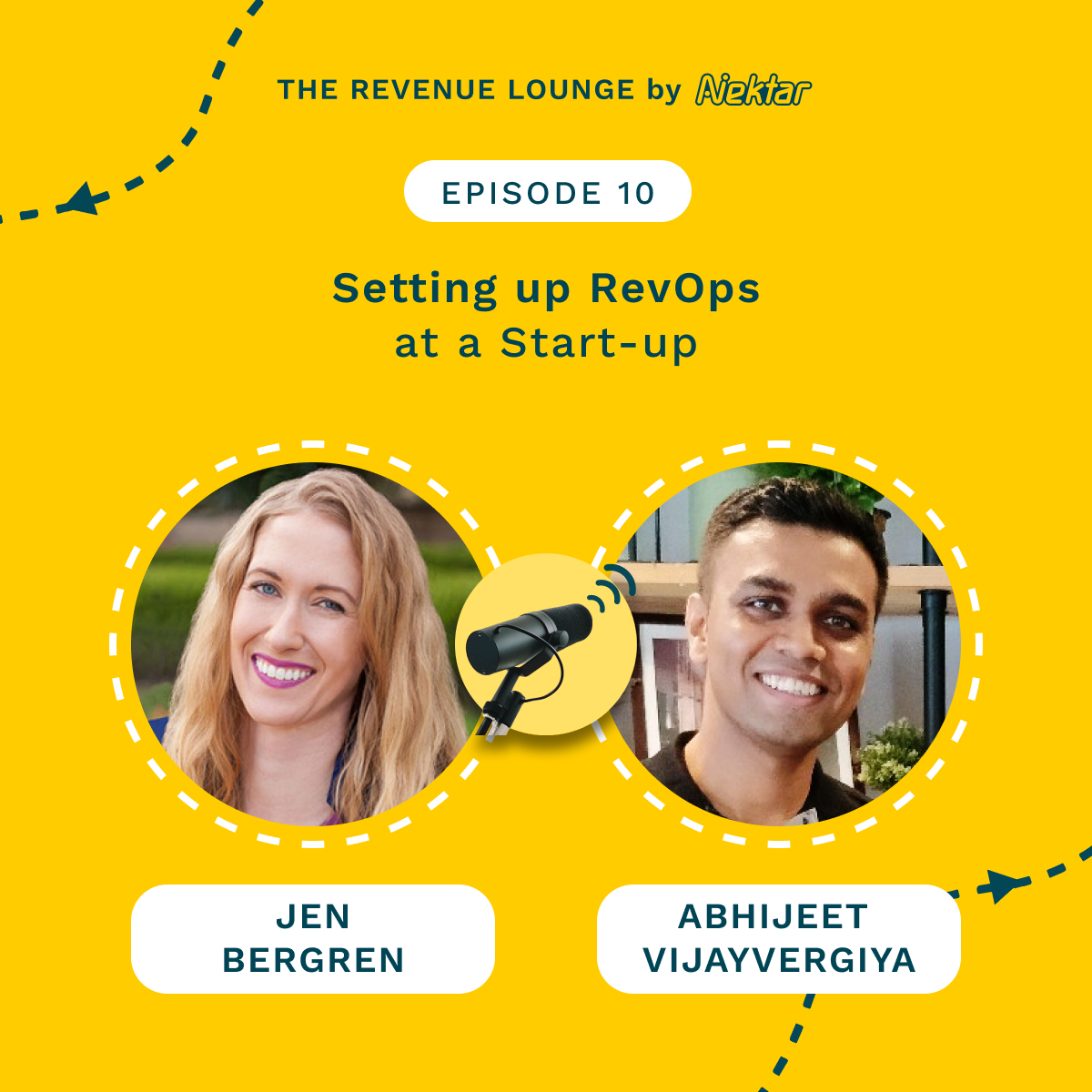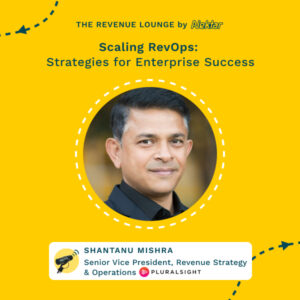Removing Friction from the B2B Buying Process ft. Mary Grothe
March 6, 2024
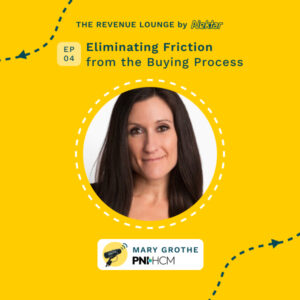
About
The Revenue Lounge
The podcast covers stories from leaders across RevOps, Sales, Customer Success, GTM, Data and Marketing about what drives these functions and what advice they would share with our listeners. With 3 seasons recorded, the podcast currently features 50+ enterprise leaders in the B2B SaaS domain. Tune in to hear from the best in the business
In this episode of the Revenue Lounge podcast, host Randy Likas interviews Mary Grothe, the Chief Revenue Officer at PNI.HCM about strategies for identifying and eliminating friction from the buying process. They discuss Mary’s career path, her perspective on revenue operations, common pain points and friction that buyers experience, and how revenue leaders can adapt to changing buyer behaviors. Listeners can expect to learn about optimizing the buyer’s journey, key metrics revenue teams should track, and advice for aspiring chief revenue officers.
Guest Bio:
Mary Grothe is the Chief Revenue Officer at PNI.HCM, a payroll and HR solutions provider. She has an extensive background in sales, marketing, and revenue leadership. Mary has run multiple startups, hosts the Destination Remarkable podcast, and is a sought-after keynote speaker.
Company Bio:
PNI.HCM offers payroll, HR, benefits, and other human capital management services to organizations across the country. They aim to provide an exceptional customer experience supported by innovative technology.
Key Quotes:
“Revenue operations is the combination of the operational workflow, the actual like people doing the work in revenues, the behaviors, the process, the job from marketing sales CS and then the technology that supports that.” [00:07:11]
“If the incentive plan or the metrics plan doesn’t align with the way that the buyer wants to buy and it’s prohibiting us from doing the things that we need to do in order to move revenue through the funnel, especially right now, we have to change it. There’s no if, ands or buts.” [00:24:41]
“Attitudes are contagious. Is yours worth catching?” [00:47:13]
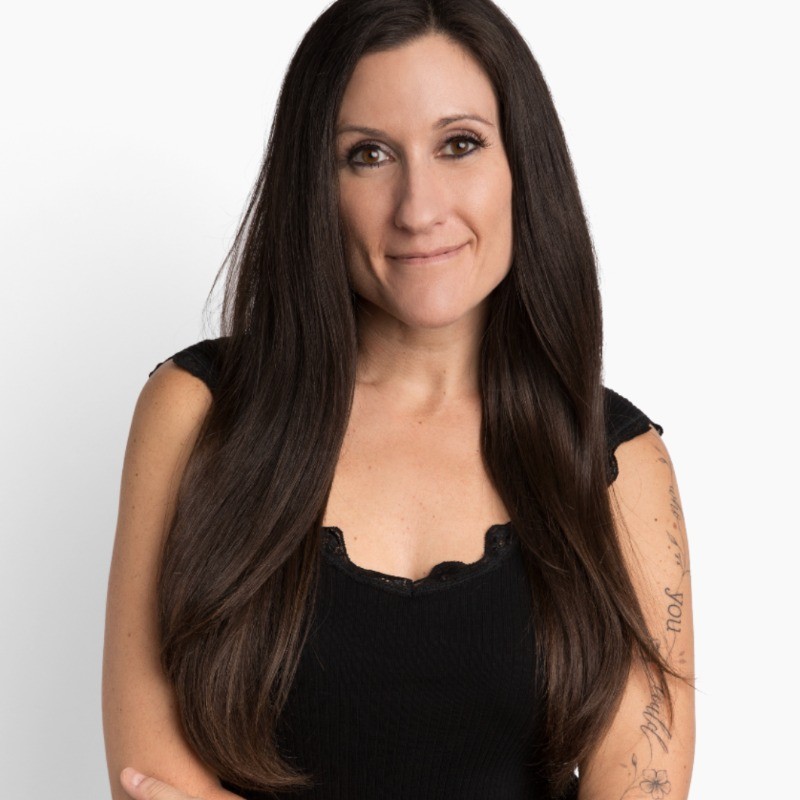
[00:00:07] Randy Likas: Whether you’re a customer looking to make a purchase or a business trying to streamline your sales processes, friction can be the enemy that slows everything down. It’s important to understand the buying process, the friction the frictions that exist in it, and how they can be addressed. Hello, everyone. Welcome to the Revenue Lounge podcast. I am your host, Randy Lykkes.
[00:00:25] Randy Likas: And today, we’re going to dive deep into the strategies, innovations, and insights that can help us identify and eliminate friction from the buying process. And joining me today is Mary Grothe. Mary is the Chief Revenue Officer at PNI. She’s a revenue leader, entrepreneur, global keynote speaker, the host of the podcast, Destination Remarkable, and former contributor to the podcast, Revenue Radio. Hi, Mary.
[00:00:48] Randy Likas: Thank you so much for joining us today.
[00:00:50] Mary Grothe: Hello. Thank you for having me.
00:00:53 Mary Grothe’s Journey into Revenue and her Role as a Chief Revenue Officer at PNI
[00:00:53] Randy Likas: So, Mary, maybe we can start and you can tell me a little bit about, your role currently at, PNI.
[00:00:58] Mary Grothe: I’m a chief revenue officer, and I love it because it’s the actual definition of a chief revenue officer, not that other definition of a chief revenue officer, which is a glorified sales leader, which there’s absolutely no shame in just calling them a chief sales officer or VP of sales and not giving them a CRO title because that’s, at its core, not what a CRO is. So a chief revenue officer should have the privilege of overseeing all of revenue. So we’re talking about brand marketing, the go to market strategy, sales, all presales elements, customer success, any retention efforts, customer marketing, and and whatnot. I have the privilege to do that. I love my role.
[00:01:36] Mary Grothe: I grew up in payroll. I started in payroll when I was 22. So some people are like, Payroll? Like, that’s a thing. Yes.
[00:01:42] Mary Grothe: It’s a thing. There are payroll companies out there. They actually process the payroll checks, pay taxes. It’s it’s a whole industry. I started in that industry.
[00:01:49] Mary Grothe: I’m so glad to be rejoining it after my crazy career that I’ve had thus far.
[00:01:54] Randy Likas: That’s great. How did you get into, like, revenue? Whether it be from the operation standpoint or from a sales leader standpoint, what’s your story?
[00:02:01] Mary Grothe: Getting into revenue. My gosh. I’m one of those people that knew my whole life this is what I wanted to do, and that’s a joke. When I was 22, I had just somehow made it through 4 of the worst years of my life, and it’s a shock that I wasn’t dead or in jail. And at 22, I just had a fire inside of me saying I was worth more, capable of more, and I needed to turn my life around.
[00:02:31] Mary Grothe: And I read this thing called a newspaper. It’s like this piece of paper, and it had some print words on it. Okay. So I found a job in the newspaper, and I was excited because it was only 4 miles from my house that I thought, oh, short commute. And I got an office job as a district sales assistant for a payroll company.
[00:02:50] Mary Grothe: I didn’t know what any of that meant, but I took the job super fast, and I loved it. I was supporting a mid market team of 8 salespeople, and they were the number one team in the country. So I got to surround myself by these ultra top performers, and I came from pretty rough childhood background and didn’t have a lot and didn’t really understand what it looked like to make a lot of money or have nice things in life. And I was surrounded by it. Work hard, play hard, really nice thing.
[00:03:23] Mary Grothe: I thought I didn’t even know this life existed. How do I get that life? And they said, well, you could go into sales, but you’d have to go through this big, long learning. You gotta get a college degree. You have to start out in small business sales, then maybe you can work your way up.
[00:03:37] Mary Grothe: And I’m a little type a, so I said, how about no? I made an 18 month plan. I said, how about I do these things instead? I handed it to my manager, and I was really vying for a spot on that mid market sales team because that’s who I was supporting. I like the mid market, but I said to him, I’m gonna do all this.
[00:03:54] Mary Grothe: He says, if you do half of what’s on here, I’ll put you in. And I thought, okay. I’m gonna do this, and I accomplished everything on the list. And I remember that I received a a phone call. I was asked.
[00:04:05] Mary Grothe: I was called into the sales manager’s office, and our, 2nd level manager was on the phone. And he’s like, hey. We just wanna let you know we’re gonna welcome you onto the team. And it was one of the greatest moments. I was 24 years old.
[00:04:16] Mary Grothe: And 2 years as a sales assistant, got to work on some cool projects predominantly in the rev ops space. We were doing a migration from act to Salesforce, and it was my first introduction. Nobody called it RevOps in 2006, just so we’re clear. But I got to go through this migration. I got to learn about sales processes and building it all out, and I loved it.
[00:04:34] Mary Grothe: But then I got into sales, had a great 5 year run. I actually, was the number one rep, which is fun part of the story because nobody thought I could do it. And I was young and still didn’t have my college degree, and I was was working on it, but hadn’t earned it yet. And, anyway, became the number one rep. That was a lot of fun.
[00:04:51] Mary Grothe: I sold more than number 23 combined on the rankings, Broke shattered ceilings. Broke records. It was a ton of fun. But had a great run with the payroll company. Left to go work for one of my clients and took a big title, VP of sales and marketing for a very young girl.
[00:05:04] Mary Grothe: And I was able to help a very small business quadruple in size in 7 months. And I fell in love with that. I thought if I can be good at payroll, but then I can also be good at more aspects of revenues, that’s the first time that I my degree was in marketing. But it was the first time I ever really had to do anything that looked like marketing. Was successful at it.
[00:05:22] Mary Grothe: I’m like, I love both of these things. And so I started my first company, did that for 3 years, helped 36 small businesses, grow their companies, and then went back to the payroll company for 3 years. I started my second company, which is a whole journey in revenue and building, what ended up being a fractional chief revenue officer firm and elsewhere’s rev ops firm. Just exited from that, and now I have my very first, which is funny. I feel like I did it in reverse order.
[00:05:45] Mary Grothe: Very first full time chief revenue officer position now. Yes. I was the founder and CEO of a company for five and a half years that did fractional chief revenue officer work, but I have was never a chief revenue officer. But that’s okay. I am now.
[00:05:59] Mary Grothe: So I just do things a little bit backwards in my life, but that’s how I got into revenue. And once I got it, I’ve never looked back.
[00:06:05] Randy Likas: What a great story. I I love it. So diverse. Right? And really, you you did that on your own.
[00:06:10] Randy Likas: I mean, you recognized this is what I want and you went after it. That’s a great story.
[00:06:15] Mary Grothe: Thank you.
00:06:16 Defining Revenue Operations with Mary Grothe
[00:06:16] Randy Likas: How would you define revenue operations?
[00:06:18] Mary Grothe: Yeah. 1st, let’s go with the definition. So fun story. In 2019, I I was a year and a half into running my second company. And this whole, like, buzz around rev ops.
[00:06:28] Mary Grothe: What does rev ops came about? And I was sitting down with a technology professional, and we’re trying to define it, going back and forth. Like, I don’t know. What do you think it is? What do you think it is?
[00:06:37] Mary Grothe: I don’t know, but, like, this is great. So I adopted the definition that revenue operations was the combination of the operational workflow, like the actual like, people doing the work in revenues. So the operational workflow, thinking about the behaviors, the process, the job from marketing, sales, CS, and then the technology that supports that. So you have the human component, the technology component over the entire employee life cycle, and that’s how I would define revenue operations. It’s because you have to look at the tech stack, but you also have to look at the way people do work.
[00:07:11] Mary Grothe: Now you wanna make it even more complex. You actually add in the buyer and the customer into that, buyer’s journey, customer journey, and you make sure you have 3 tiers aligned. And I think that that’s where you can remove some of the friction out of, your process. But anyhoo so that’s how I would define revenue operations. I could not function as a chief revenue officer if I did not have the rev ops component of our business defined.
00:07:32 The Importance of Revenue Operations in Driving Business Growth
[00:07:32] Mary Grothe: In fact, when I first started with this role, I inherited an okay revenue engine, but it needed to be taken to the next level. And when I heard that the company wanted to adopt a pretty aggressive growth goal, so actually going to 50,000,000 in 5 years, which is a near tripling in size, I thought there is no way we can do that if we don’t have infrastructure that will support the growth. And I believe that most infrastructure conversations and activities that we do inside it’s all rev ops based. So we’re looking at the tech stack. We’re looking at the buyer’s journey customer journey.
[00:08:08] Mary Grothe: We’re getting into very granular detail on the nuances between the verticals and types of buyers that we serve, the expectations that they have, the different roles that we have, how our departments are structured, and breaking down the walls, barriers between those. And then the technology piece is critical. So, I mean, we made a lot of changes in my 1st 6 months. Made some investments in some new technologies. Got rid of some technologies.
[00:08:31] Mary Grothe: We upgraded some roles. We created a whole new revenue engine in order for us to go back out to market. We rebranded as a part of that as well. We used to be Payroll Network Inc, hence the PNI. Now it’s PNI HCM, which is Human Capital Management, but refreshed a lot of things.
[00:08:48] Mary Grothe: Now I have learned because I’m a very, like, high optimist, excited, type a step quick, fast decisions. And I’ve learned through my entrepreneurial journey of running a company that the best decisions are data driven decisions. Like, opinions are still valuable, but data is priceless. With that, revenue operations feeds me what I need every single day in order to function, operate, and make the best decisions for my company and not have too much reliance on the gut instincts, the feels, the opinions, I need it to be validated with the data. And we built good infrastructure, So I feel like the data is good.
[00:09:27] Mary Grothe: But, yeah, rev ops is deeply ingrained in my life.
[00:09:30] Randy Likas: Yeah. That that’s wonderful to hear. It’s it’s, it’s certainly not a rebranding of sales operations, right? There’s a whole different complexity involved to do revenueoperations. Correct.
00:09:42 Friction in the Buying Process: A Founder’s Perspective
[00:09:42] Randy Likas: So let’s let’s switch gears a little bit. So let’s talk about the friction, and let’s talk about it from a little bit of a different angle. As as a founder of a company and and as CRO, you’ve probably been the customer on the customer side of things a few different times. What’s been your biggest frustrations as a buyer in the buying process?
[00:09:59] Mary Grothe: That model that someone came up with 10 years ago that everybody adopted where you have BDRs and that account executives and sales engineers and all these layers in the process. Boy, is it annoying. I understand if you’re talking about an outbound strategy where you might segment the work because you have somebody who is more proficient in outbound prospecting and can do higher volume transactional type work. But when they get a qualified opportunity, they toss it over the fence. Cool.
[00:10:27] Mary Grothe: But when you’re an inbound lead and you have a buyer with money looking to spend the money, the rigid sales process that many, especially tech companies have adopted Okay. Drove me nuts. So as a founder CEO, funny story, I bought a new payroll system, which, we outgrew the one that we had. We scaled up pretty rapidly in 2021. It was a big growth year for us.
[00:10:52] Mary Grothe: And the payroll provider I had, I just didn’t feel like it met our needs anymore, so I went to market by payroll. Any salesperson that wants to do any amount of research before they hop on a sales meeting with me can see that I sold a product for 5 years in one stint and 3 years in the second stint. They can see that I had 8 years directly working for a national payroll provider. It’s so shocking of how few reps actually do the research step and know who they’re talking to. So I try to make everyone’s life better, mostly because I’m a high d.
[00:11:28] Mary Grothe: So, like, on the disc, d I s c, driver, influencer, steady relator, conscientious thinker or cautious thinker. I’m I’m a high d. I’m also an influencer. I talk with my hands. But a high d when I’m in my executive like, wearing the executive hat.
[00:11:43] Mary Grothe: Time is my most precious asset. So I’ll slow down on this story. I need to buy a new payroll system. I know I’m I know who I’m not reaching out to. Okay.
[00:11:55] Mary Grothe: Cross this off the list. I wanted to explore PEO, which is different from traditional apparel because it lumps in benefits and stuff. Just because the size we were, we couldn’t get large group benefits. I’m like, I’m gonna investigate a PEO and see if that’s something that we can do to stage the game. But I also wanna look at payroll, and I want really good technology.
[00:12:13] Mary Grothe: I didn’t want some old, outdated, clunky stuff that’s just been reskinned, and that’s some of the stuff I used to sell at my former company. And so I get in I I start doing some searches online, and, of course, then I get probably flagged through some intense software. Somebody knows that I’m searching. Mhmm. So all of a sudden, I get delivered an ad for a company and I on Instagram.
[00:12:36] Mary Grothe: I’m like, wow. They found apparel. I’m like, that’s awesome. So I click it as I’m sitting on my couch one night surfing in my newsfeed and I become an inbound lead. And on the inbound form, you have to answer some questions.
[00:12:49] Mary Grothe: I was like, I got this. I can do that. So then I get an email from the BDR. Before they can set a meeting with me, I have to answer the exact 5 questions I’ve already answered on the form. So I’m like, okay.
[00:13:05] Mary Grothe: I’ll play because I really wanted to see this software. So I answer these questions. Then I wait, and I wait, and I finally hear back. And, okay, I passed the test. So now I can get scheduled with an account executive.
[00:13:20] Mary Grothe: So then we have to go through calendar Volley. We finally get some things scheduled, and we finally get on a meeting. And I want I just want to see it. I just want to see the technology. I already can qualify myself.
[00:13:33] Mary Grothe: I know what I need. I’ve been around the block. So I went through this process, not only with the one with the Instagram ad, but with several other companies so I could do a really good thorough analysis. And the Instagram ad salesperson account executive, when he got on with me, he was the only rep that researched me, knew who his audience was, and custom tailored the process for me to buy. The other four opportunities made me go through this unbelievable, ridiculous waiting game of like, am I even gonna hear back from it?
[00:14:08] Mary Grothe: Like, I have money to spend. I’m a qualified buyer. What is wrong with these people?
[00:14:12] Mary Grothe: And anyhow, one guy at one of the companies took the Zoom call from some sort of like swing that he had inside of his apartment and was holding his laptop like this while we were on. And he actually had it down, so I was, like, looking up his nose. And then through the collies, like, my computer is running out of battery, you know, like, doing this to go over to his table to get a charger. I’m, like, this is how salespeople sell. Anyway, so I’m not trying to bore you with all these stories.
[00:14:44] Mary Grothe: But the guy who got my business was the one who showed up, and he’s like, it looks like you know a thing or 2 about payroll. So how do you wanna go about this meeting? I’m like, oh, thank you. So we had an I do that. Process.
[00:14:57] Mary Grothe: He was tremendous. He’s also super smart. He could demo his own software. He demoed it from your rental call. We went straight to pricing.
[00:15:03] Mary Grothe: Mhmm. And I made a decision. Even though I still had to go through the annoying BDR qualification, like, can you just kill that process? Like, okay. So on inbound leads, kill the process.
[00:15:13] Mary Grothe: On that, as a CRO, I have recently bought some software. And yet again, I was looking I was buying intense software and data source software. Awful experience, Brandy. I’m just like, why did you take this many steps, and why am I repeating myself on every single meeting? You guys not talk to each other.
[00:15:36] Mary Grothe: And why is there such a lag time in getting things scheduled? I even had some of those intro calls get get canceled on me. Yeah. Or reps not show up. What?
[00:15:46] Mary Grothe: What day do you need to removing it? Are these companies just so spoiled with their brand recognition that they just don’t have to show up and take care of the buyer? I mean, it was so bad. So yet again, the intense software we ended up buying was because the sales person was one of the best sales people I’ve ever bought for in my life. And he knows us and I talk about him on stages all the time.
[00:16:04] Mary Grothe: But he was so custom tailored to what we needed on our timeline. So thorough, so communicative, so smart, could demo it himself. That’s the kind of salesperson we need to be putting in front of buyers. And I do think, like, there’s so much that companies can be doing right now, especially because sales are down for a lot of companies. Pipelines are down.
[00:16:24] Mary Grothe: Length of sales process has elongated. We have a lot of things that we’re seeing with the shift in the economy. If you’re not putting the best of the best person, especially on your inbound leads to get to converging, like, you’re messing up. If you’re giving new reps or underperforming reps an opportunity with these, it’s like, you gotta reevaluate what you’re doing because that buyer’s gonna get super frustrated, and you’re walking away from revenue. Like, you gotta put the best ones in front of it, but there’s just two examples there.
[00:16:48] Mary Grothe: Hopefully, people enjoyed the demonstration.
[00:16:51] Randy Likas: Those are great examples and we see it all the time here as well. I think part of it was like, you know, with the pandemic, it’s for some companies, there was all this demand that was coming in. They had to establish these formal processes, and they haven’t adapted over the past couple of years because you are right. It is so much different now than it was 12, 18 months ago. So drawing from those experiences that you just had recently, what could a rev ops professional at those companies do to help mitigate some of that rigidness of the process in order to make it a more buyer friendly way?
00:17:23 Insights on Overcoming Friction in the Sales Process
[00:17:23] Mary Grothe: Well, 1st and foremost, voice of the customer surveys are some of the greatest things. Those aren’t a survey you send out. Those are live conversations to get direct feedback from the person who just went through the process on the buyer side. Yep. There there’s so much value in those, and I think they’re completely underrated.
[00:17:39] Mary Grothe: And I do believe that that is one avenue to understanding what the buyer actually wants, what they found beneficial, what they found frustrating, what worked for them, what didn’t work, what they would love to see more of, less of. I think that that’s tremendous, and even being bold enough to ask them how it compares to other companies that they’ve met with. It’s also soliciting feedback when you win and when you lose deals to understand what step of the process it started not to resonate with them, where it fell apart. And I’m not just talking about sales. I’m actually talking about process, steps of the process.
[00:18:09] Mary Grothe: Sometimes you need to hear feedback like, we didn’t want to wait x amount of time to get a demo, or we found it frustrating that the first person who demoed for us wasn’t the same person who demoed for us the second time because we found that that second person wasn’t as effective. That’s when we brought our executive team in. Like, there are things that you could learn in the process that by asking people for the feedback, it’s like, what a concept. Right? Let’s go to the buyer.
[00:18:31] Mary Grothe: Let’s go to the customer, and let’s point blank ask. Sometimes we can’t get that data. I love secret shopping. I love finding out what the competition is doing. So, secret shopping is key.
[00:18:42] Mary Grothe: Now, I’m gonna talk about both sides of my mouth. I understand why some companies have a rigid inbound qualification process because they are screening out and they have found that as a part of their revenue funnel efficiency
[00:18:59] Mary Grothe: That in some cases, it’s almost worth the risk to frustrate a qualified buyer with rigidity of process because they may have a volume of unqualified leads, spam, fraud, whatever doesn’t fit our ICP, and they have found that putting in the qualification steps helps weed out some of the crap out of their funnel and they get better. So I understand that. But I there’s never, like, a perfect answer on this, but I do believe that a rev ops team has got to look at the data. So there’s objective and subjective. You can look at the data.
[00:19:36] Mary Grothe: You can understand. Like, I I run a funnel report. I live off of this report, And I look at it by team that I have so I can see who’s converting what percentage to each step. And then above the funnel, so it starts with deal stage 1 that I’m looking at. I wanna look at who’s not converting.
[00:19:51] Mary Grothe: So very transparently, I found a performance challenge because we had a rep that had the lowest conversion rate from discovery to demo, whereas everyone else was almost a 100% conversion from discovery to demo except for a few rare cases of sales and qualified being the deal stage coming out. And I’m like, this is a massive issue. We have a wrong fit in a role because there isn’t enough value being created. The conversation is not strong enough. So, of course, first first thing you do is you’re gonna hit it with training and enablement and work through, but, you know, eventually, you may come to the conclusion that’s a wrong fit for a role.
[00:20:30] Mary Grothe: So, like, that’s real. But being able to look at the conversion step process, but then we need to take it back a step. So not just funnel from deal stage 1, but how are you feeding the funnel? Where is it coming in? And I do believe that rev ops is not sales ops because how do you feed the funnel?
[00:20:44] Mary Grothe: You have brand awareness activities that are like ultra top of funnel. You have all of your social. Then you have your marketing channels that are very defined, very specific, very strategic. Then you’re gonna have things like your event strategy, but you’ll have big national trade shows. You’ll have target events.
[00:20:59] Mary Grothe: You’ll then have networking events. You’ll have those you sponsor, those you exhibit, those you attend, all these different granular layers. And so a rev ops professional can truly understand this data and understand when it comes from this level of a lead source, how it then also converts to the funnel And other metrics like what’s a great average revenue, what’s the health of a deal. So when you take the data components of it and then you couple that with actually asking about the experience, you’re starting to understand what does the buyer actually want. When you can go through some secret shopping sorry, that let me down on tangent.
[00:21:29] Mary Grothe: But when you can do some secret shopping and understand what the competition is doing, it’s very, very helpful because I think we don’t have to recreate the wheel. When somebody gets it’s like, this is good. You know, like, when people started to put calendar links on their website Mhmm. That removes friction from the sales process.
[00:21:45] Randy Likas: Yep.
[00:21:46] Mary Grothe: That’s awesome. Right? We’re gonna roll ours out. We just had to redefine our geographic areas, our segmentation. You know, if anybody tries to go fact check me and they look at the website, and they’re like, PNI does not have a schedule function on here.
[00:21:58] Mary Grothe: It’s not there yet because I don’t rush to roll things out that aren’t gonna be the right result. So, I’d rather delay and wait to build the right infrastructure. So, I had to build all those things internally, then we’ll get calendar links on, and we’re gonna have our screening questions and things because there’s a lot of fraud in the payroll industry. So we have to be able to screen out fraud and do other things. So, anyway, there’s a lot of steps to that.
[00:22:19] Mary Grothe: But that’s another area. Like, you have to identify and understand where you can fix it and then convert it.
[00:22:27] Randy Likas: How does a rev ops person who’s doing the things to to identify the friction, but then they go to the the person who’s leading the SDR organization and say, we we’ve got to change the process because this is not aligned with how the buyer wants to buy, but yet you’re being measured on the amount of, you know, of conversion from, you know, for at 1st SCR meeting to AE handoff. How did they go about overcoming some of those challenges where a frontline manager or leader has a metric that they’re being measured by and the rev ops person says, yes, but this is not what the customer wants clearly through the data. How do you work through that? How does a rev ops leader who has gone through and done the analysis and has the data on how the customer wants to buy? They’re identifying the friction in the process.
[00:23:15] Randy Likas: So in the example of I don’t need an SDR qualifying me through these 5 questions. And so they go to the the the SDR leader and they say, look, we got we’ve got to streamline this a little bit. But the SDR leader says, yeah, but I’m I’m measured on my amount of leads that that we are able to qualify and turn over to an AE. How does a rev ops person overcome those competing priorities?
[00:23:37] Mary Grothe: Yeah. That’s a challenge, isn’t it? And that’s real, and it happens everywhere. And I feel like that’s where a chief revenue officer takes the data from rev ops and advocates inside the organization for change. Yep.
[00:23:49] Mary Grothe: That is why when I opened this call, I said I have the privilege of being a real chief revenue officer, somebody who was given, say, an authority over all of revenue, not a glorified sales leader because that’s where I believe conflict is created because revenue, we’re looking at one funnel and yet we have all these department heads and initiatives. And if we’re not talking to each other and collaborating, a chief revenue officer should own, in my friction, and it’s different with different size companies, stages of companies, if they’re in growth mode, if they’re in maintenance mode or, you know, there there’s always nuance. Okay? But if the incentive plan or the metrics plan doesn’t align with the way that the buyer wants to buy and it’s prohibiting us from doing the things that we need to do in order to move revenue through the funnel, especially right now
[00:24:41] Randy Likas: Mhmm.
[00:24:43] Mary Grothe: We have to change it. There’s no if, ands, or buts. There are no other options. If if you put me at that table and say, what do we do? We change it.
[00:24:52] Mary Grothe: Yep. Nothing is more important than creating an experience that is going to create conversion. If we’re doing work for the sake of doing work or we’re tracking metrics for the sake of tracking metrics or we’re paying out on metrics that don’t the right behavior to get conversion. We have it all brawn. And that’s one of the pieces that I love about a chief revenue officer.
[00:25:15] Mary Grothe: For years in my last company, the 1st couple of years, we were friction VP’s of sales, but I took that pivot in 2019 to learn revenue operations, learn marketing, learn go to market strategy. And the last two and a half years that I ran that company, I was the a very outspoken advocate for a real chief revenue officer and helping people understand what this role does. And the other thing is, is it takes time. You look at VPs of marketing, VPs of sales, CMOs, average tenure in those roles are like 18 to 22 months, maybe 24. Super high turnover.
[00:25:51] Mary Grothe: Because executive leaders, I think it rests on 2 things. 1, they don’t know what that role really does. They’re not also given the right budget, the right runway. I think that it’s a very difficult role to understand, but I also think that there are a lot of people in those roles that maybe aren’t the right people. So a lot of issues happening at that level.
[00:26:12] Mary Grothe: But, ideally, a chief revenue officer should be given the budget, the ramp, the time, and the ability to go through this process, audit research, build test, optimize and scale. So many times, companies, especially, you know, in growth mode or they’re trying to cure a revenue plateau, like, we we’re gonna the budget is going to the CRO that we’re hiring. And then the CRO is like, well, I need a $1,000,000. No. No.
[00:26:41] Mary Grothe: No. Our budget went to you. We have you now, so do the thing. It’s like, well, the thing costs money, and it and I need a team, and I need technology, and I need time. And I think the biggest thing that we don’t get is the time.
[00:26:54] Mary Grothe: It’s like, oh, we have the person now. Okay. Wait. Well, we let you spend the money on the technology you needed. We let you hire the people.
[00:27:00] Mary Grothe: Okay. But I also need the time. Mhmm. In order for the seed planting to occur and the harvest to grow. Yep.
[00:27:07] Mary Grothe: I don’t know if I answered the question. What was
[00:27:08] Randy Likas: the No.
00:27:09 The Importance of Analyzing Changing Buyer Dynamics in Revenue Operations
[00:27:09] Mary Grothe: Oh, SDR. Yeah. How so the rev ops to the SDR beta juror. I I truly think that rev ops needs to work with the CRO as long as the CRO has oversight of all of revenue because then the data that then the CRO is the advocate for the change. I think it would be a very difficult situation for rev ops professional to have to go make a case to a siloed department to tell them that data says they should be doing something differently, but it’s an opposition of how they’re managed, the metrics that they’re managed to, which is, like, their job rights on it and potentially compensation
[00:27:45] Randy Likas: Yep. Lost cause. Yeah. Without that alignment from a CRO who’s bringing those together, it’s nearly impossible. Let’s pull that thread a little bit on time in needing the time.
[00:27:56] Randy Likas: So, you know, you’ve got the right systems in place. You’re collecting the data. You’ve got the analytics. How often should a rev ops leader look at the changing buyer dynamics in order to make those changes?
[00:28:08] Mary Grothe: I look at them every day. I don’t know any other answer than that, especially in the economy and market that we’re in right now. Things are changing. Everything in a post COVID era, I feel like COVID sped up. Yeah.
[00:28:25] Mary Grothe: I mean, look what it did to the supply chain. Look what it did to innovations in ecommerce. Look what it did to video conferencing and other technologies that enable us to be a remote workforce. And it sped up so quickly, but then it kind of like demolished other concepts and industries and ways of doing things. And I still feel like the market and the buyers, they’re it’s all recalibrating.
[00:28:51] Mary Grothe: It’s not sealed out. Like, we don’t have linear, this is the data set and this is going to be what it’s going to be now. So let’s build everything around this. There’s an agility that has to be built in to everything that we have right now. So case in point, I started on contracting this job in October.
[00:29:12] Mary Grothe: It took me, like, 3 months to get a clue. I mean, I was trying to hit low hanging fruit. I was trying to understand what was working, what wasn’t working, immerse myself as much as possible, but I was fractional. So I was a fractional CRO for the 1st 4 months. I was owning and running my company while I was.
[00:29:28] Mary Grothe: So I did the best that I could. I wasn’t all in. I was pushing maybe 15 to 20 hours a week, not enough time. I went full time on January 30th. And when I went full time, it was like double full time.
[00:29:38] Mary Grothe: I mean, I went in all in. We’re talking 60, 80 hours a week. When I got in there, I had to focus on understanding how the buyer had changed because I hadn’t worked in payroll since 2017. So I’m like, how has the buyer changed? What do we need to be doing?
[00:29:54] Mary Grothe: And in this post COVID era, where are they? What channels will we find them? What’s working? What’s converting? And so there was a hypothesis that was built.
[00:30:01] Mary Grothe: So I said audit research and then build in task. So this hypothesis was I think this is the plan. So I had a plan, like, a bridge plan to get us through the end of the fiscal year, which experience June 30th. And so really from January 30th to June 30th, I was like, this is, like, our bridge plan. But during the bridge plan, to do the best that we could to to do our rebrand, but to still drive volume into the pipeline and close business.
[00:30:24] Mary Grothe: In addition, I was building a whole brand new team. I hired a plethora of people, rolled out new technologies, and the plan was to launch this whole new team and tech stack and everything, way of doing things on July 1. And that’s exactly what we did. So I had a hypothesis. We did some building and testing through the remainder of our fiscal, and now we’ve been live for 8 weeks.
[00:30:48] Mary Grothe: Mhmm. There’s some good data here, and I’m already making changes. Wow. Because if I wait I originally thought 90 days was a good like, give let me do 90 days. But I already see leading indicators in the 1st 60 days that nothing in the next 30 days is going to change my opinion on what I’ve seen in the 1st 60 days.
[00:31:10] Mary Grothe: And I’ve been monitoring them every single day to understand when I’m gonna need to pivot in order for us to not build a huge deficit. So we’re not hitting our number right now, and that’s okay. Majority of teens are hitting their number right now. That’s fine. But 8 weeks in, I’m making changes because I don’t want to accumulate a deficit that I’m not gonna be able to get out of before the end of this fiscal year.
[00:31:34] Mary Grothe: Yep. And so every day, I’m accumulating debt. And I, as the chief revenue officer, I have to be able to look at the data, interpret the data, and pivot timely without disrupting too much. And it’s hard. But
[00:31:46] Randy Likas: Let’s Let me ask you the very tough question to answer. How much change is too much? Right? How much change can you roll out before you it it just too much?
[00:31:55] Mary Grothe: Yeah. Okay. I would because everybody has their own level of change that they can endure, it really is a question dependent on the people that you’re surrounding yourself with. Too much change is the change that hinders an employee’s well-being or it hinders the ability to hit a target because I would say change that allows you to hit the target, but you burn people out or you lose people along the way or you create an environment that just isn’t sustainable even if you hit the target, that was too much change. I don’t think it’s worth it.
[00:32:34] Mary Grothe: So I think the fine line is as least disruptive as possible while still protecting the ability to hit that number. If if that answers the question, I can dive deeper, but there’s no it’s just a job, for goodness sakes. Like, we can’t have people as casualties
[00:32:53] Mary Grothe: Just to to win. Yeah. Because, unfortunately, I know that because I did it in my business, and I burned out a lot of team members. As a start up scale up CEO, it was like a win at all cost mentality, question. It’s a bad mix.
[00:33:14] Randy Likas: Yeah. It it’s it’s the reason why I asked the question is, you know, look at what’s happening right now, and I think it’s a function of sort of where where we’ve been the past couple of years after the pandemic is the traditional ways of building top funnel anyway of reaching out through email and and pick you know pick up the phone and trying to get people on the phone it’s just not working the way that it was before How much do you have to double down on on sort of what has been successful in the past, but it’s not working now versus find other ways. And and and this ties into, I think, the buying experience. Right? The reason why people are not responding back to emails, they’re getting inundated with way too many.
[00:33:51] Randy Likas: They’re doing research on their own. They don’t have to speak to a salesperson right away because there’s more available to them to to when they’re in market, they can do more on their own. So I guess it ties a little bit into the friction and the change sort of tie in together. So what are you seeing as far as, like, the rev forever revenue operations leaders? How do they look at, like, the metrics in which they should look at this these changing fire dynamics or friction to help them understand whether or not what they’re doing is good or they need to make those changes.
[00:34:22] Mary Grothe: Yeah. Well, I’m in the thick of that right now because that’s part of what I’m evaluating in our go to market is how we’re doing lead gen. And in order to accumulate data out of the gate, I I got budget and permission to try a whole lot of different things Yeah. Because I just don’t know the answer to that question until we go accumulate the data. So for me, we’re doing it all right now.
[00:34:46] Mary Grothe: I mean, we have irons, every iron you can think of in the fire as far as from the digital side to in person donut drops, to handwritten direct mail, like hand addressed direct mail, and everything in between, intent software, email sequences, social media, organic, paid paid media, or content. I mean, you name it, we’re doing it right now.
[00:35:17] Randy Likas: Yep.
[00:35:18] Mary Grothe: Here’s what’s interesting is I feel like we were warned. Like, how many podcasts did you listen to? Blogs did you read? Seminars that you sat at? People that you heard say, the buyer takes in sales 80% of the way before they engage sales.
[00:35:32] Mary Grothe: Like, this is a stat. It was like a warning that was spoken to all of us revenue leaders for the last 5 years. This stat has been so popular. I have also said it in my presentations. The buyer is now taking themselves 80% of the way.
[00:35:47] Mary Grothe: What are you doing to create an experience for your buyer that they’re choosing you as a top contender during their 80% process? And I still feel like revenue leaders are not clued in on this. And so we had a good economy. We had good inbound. That has changed.
[00:36:05] Mary Grothe: Teams now are rushing to figure out how to do outbound again. But then now, like you just said, we are killing our buyers because we’re just inundating them, and it’s so noisy. How are you gonna stand out?
[00:36:24] Mary Grothe: How are you gonna stand out? And so I have some guesses that I’m working to validate. I think the relationship, whoever owns the relationship is gonna win.
[00:36:39] Randy Likas: Yep.
[00:36:41] Mary Grothe: So are we gonna go back to finding our referral partners, our trusted advisors, our COIs, and building strategically on top of other reps like us who have the relationship, but we have a noncompeting sale? Are we gonna double down on the 80% educational component on our marketing efforts? Are we going to get more creative from a brand awareness standpoint? Like, I remember when I my first company that I started, I helped a business that was in the auto repair, collision repair. And I was kinda newer as an entrepreneur.
[00:37:16] Mary Grothe: I had traditional clients where you could do, like, traditional marketing. You get somebody excited, and then you get a conversion. And he said, Mary, we can’t do traditional marketing. You can’t like go market to somebody, and then they bring in a perfectly fine car because it we’re a collision repair. We have to be so top of mind for them that when the collision occurs, they don’t think of anyone else but
[00:37:42] Mary Grothe: So how do we do that? It’s all brand awareness. Right? So for these people, it’s like bus stop advertising, radio advertising, a catchy jingle that you sing over and over and over. It’s signage.
[00:37:50] Mary Grothe: Catchy jingle that you sing over and over and over. It’s signage, like billboard signage in the geographic area where they know, scientifically proven, data proven, that they have a radius that’s gonna bring their car there to serve, and then they need a competitive differentiator that’s gonna stick out. And their competitive differentiator is that they fight with insurance companies. Because in collision repair, what they don’t do, because a lot of insurance company will only, like, authorize refurbished parts or, you know, they cut corners. They will never cut corners.
[00:38:19] Mary Grothe: So, their big claim to fame on other radio advertising and everything is always about, like, we fight with insurance companies because you deserve the absolute best in your car and not cut corners. So, that all understanding our buyer, where the conversion point is, and the education that needs to happen before that? What is the trigger event? And then are we custom tailoring all of that? So So in my industry specifically, we’re selling payroll and HR services.
[00:38:46] Mary Grothe: We sell the HR and finance and accounting people. And then we have executive decision makers typically. They’re usually not super ingrained in the process depending on the size of the company, but, like, our champions are, users of the technology. Those are all HR payroll people. But we need to get the relationship with them, and we need the brand awareness so that they even know that we exist.
[00:39:05] Mary Grothe: So for me, I’m focusing on where we can get in front of them, like, physically in front of them. So events is huge for us right now as well as getting the right content out online and in the right channels so that they we can be a partner in educating them. We’re also helping with, like, SHRM certifications, continuing ed credit, working on that angle to get the people out and getting in front of them. But for every business, it’s gonna be different. It’s just how are you doing the exercise to figure it out.
[00:39:31] Randy Likas: Yeah. So if I’m hearing you correctly, and I’m gonna play it back a little bit, the way in which we build to build top of funnel for right now, the way in which we have to go get the attention, get the interest is changing. And we are trying many different things right now to try to make that happen. Does the measurement in which we know whether or not we’re successful, does that change? As you’re changing the how does the what actually change?
[00:39:55] Randy Likas: Meaning we need so many leads in order to have the right conversion and it’s a different time element. Right? You’re spending time doing donut drop offs. Are you spending time at events? So how do you change the metrics to make sure you
[00:40:08] Mary Grothe: still hit your growth numbers when the method’s actually changing? Yes. Well, I think personally, what I will start looking at is the revenue attribution. So if I I wanna look at patterns. I don’t think we’re gonna get a conversion off of one touch point.
[00:40:23] Mary Grothe: Mhmm. So I wanna use some revenue attribution reporting to be able to understand when it’s this combination of activities, this is when I get conversion. So as an example, if I’m running 2 different sequences, let’s say a sequence is a connect on LinkedIn, a an email, automated email with some customization, a phone call, a LinkedIn message, another email, another phone call, and then I send them, you know, a letter. If that’s the sequence, it’s all digital, it’s all from behind my desk, then what is the conversion? How many touch points?
[00:40:55] Mary Grothe: Like, at what step in the process did I get a yes, no, and unsubscribe, you know, or a conversion step? But then if I look at something that’s more, like, where they hear they saw us on an event, they got enrolled in a sequence, but we had a touch point. The first touch point was at an event, or we did a drop, or we did a thing that was more in person. What how many steps of the process until we got the conversion? Then what happens if we just get the introduction through a COI?
[00:41:19] Mary Grothe: Then a lot of times through through a trusted, there’s no LinkedIn connect. There’s no drop. There’s no mailer. There’s no email. There’s no phone call.
[00:41:26] Mary Grothe: Like, if we look at the steps of the process but we have to do it all in my opinion. Like, we should be diversifying our revenue streams. Yep. We should be diversifying our lead sources, diversifying our activity. If we’re doing a whole lot of a little, you know, a little bit of a whole lot of things when we have a lot of opportunities and this is where we have diversification in the funnel.
[00:41:46] Mary Grothe: But if you run this over time and the data comes back to say that your conversion point is 300% greater on don’t do the other stuff anymore. Cut it. And that kind of went to my earlier comment. Like, this is where rev ops, when they’re able to help identify efficiency inside of revenue funnels, Like I was saying earlier, whereas from a buyer perspective, I didn’t really love having to go through all the steps of qualification and repeating myself, but maybe that company had the data to say that when their account executives only had meetings put on their calendar that were high value prospects ready to buy of this size, number of employees, whatever, then they sold 2,000,000 a year. But when we let a lot of the funnel come through, it actually hindered their efficiency inside of the funnel, and it attacked their efficiency 50%, and they’re only selling a 1000000 a year.
[00:42:36] Mary Grothe: Well, that’s an issue. Right. So then I can see why the company wants to work harder to screen people out even though it’s not in the best experience of the buyer. So revenue is fun, isn’t it?
[00:42:46] Randy Likas: What I love about that, and and you I think you nailed it is let the data you have to have the data to help you understand where we make those changes and how we might change the metrics. So love that. Okay. We’re at a point in the call call. We’re gonna change it up a little bit, the formatting, and it’s gonna be a little bit more rap rapid fire.
00:43:02 Interview with Mary Grothe about her role as a CRO
[00:43:02] Randy Likas: So first question I’ll ask is, what’s one book that you’ve loved in the recent past?
[00:43:07] Mary Grothe: Yeah. So I’m a woman of faith, which is difficult to exist in corporate America or in the marketplace. So most of the literature that I read is very faith based, and my favorite recent book would be Crazy Love by Francis Chan.
[00:43:21] Randy Likas: And and why is that? Tell me a little more about that. Why why do you love that book?
[00:43:25] Mary Grothe: Well, I love it because it convicts me, And it keeps me centered on reminding myself what’s important. I love being in revenue. I love being an executive leader. I love doing this, but this is not why I was created and put on the planet. And it’s a constant reminder of me as a human that I have the ability to create an experience for people that I interact with that improves their lives.
[00:43:50] Mary Grothe: Like, being the love and the light. Humility, grace, kindness, mercy, all of those things that come from the fruit of the spirit. I have an opportunity to be that for people that I work with, my clients, my employees, my colleagues, teammates, peers inside, outside the company. And it’s a good centering activity for me to immerse myself in that book to remember that, yes, that’s great. I know a couple of things about sales and marketing, and that’s awesome.
[00:44:16] Mary Grothe: And maybe I’ll be successful in my career, but at the end of the day, that’s not what I’m gonna be remembered by. And I don’t believe that’s why I was created. So how can I be the love and the light and carry this out? And so this book just is a pure conviction in my heart to remember that, like, all the stuff I do professionally is cool and all, but at the end of the day, I’m here for something greater.
[00:44:37] Randy Likas: So true. And I completely believe that as well. One of the things I love about doing these calls is my reading list is now going higher and higher. Right? So I’m gonna be adding that to my list.
[00:44:46] Randy Likas: Let’s talk about your favorite part about being a CRO.
[00:44:49] Mary Grothe: I know. I think it’s just a compliment that I’ve been entrusted with so much. I think for me, that allows me to look back on my career and know it was all worth it And to sit in this seat and to realize that I have executives and the owners of our company that have looked at me to say, we believe in you. We trust you. It’s one of the greatest feelings I’ve ever had professionally, one of the biggest jobs I’ve ever had.
[00:45:18] Mary Grothe: I thought being a founder CEO was hard, and it was extremely hard for different reasons. Yeah. This is so different, and it’s in it’s exciting and it’s just injected me with this new life and passion. But I think the best thing about it is receiving the compliment that somebody believes in me and trusts me as much as they do, that they’ve put me in this seat.
[00:45:38] Randy Likas: Yeah. That’s awesome. On the flip side, what’s the least favorite part of about your job? Or set it a different way. What’s hard about your job?
[00:45:45] Mary Grothe: Yeah. That I own all of revenue. I mean, it’s just the inverse.
[00:45:50] Mary Grothe: It’s hard because it’s really easy to mess up. Yeah. When you have this much responsibility and you’re trying to get it so intricately connected, well, we all know if one piece goes out, it can have that snowball effect. And so it’s a lot it’s hard. And and some days, you know, there’s a little bit of fear of when I make this quick decision, am I forgetting who this might impact?
[00:46:13] Mary Grothe: And but I have to move at a speed and a pace if we’re gonna accomplish the growth and the scale. Yeah. And so it’s hard. And there’s always that little voice of, like, cautioning myself. It’s hard.
[00:46:23] Mary Grothe: It’s a big responsibility.
[00:46:24] Randy Likas: Yeah. It’s one that I think also comes with experience to just trust that it’s okay not to know everything. It’s okay to do some things. It’s okay to mess up once in a while, but have trust in yourself. Right?
[00:46:34] Randy Likas: What what’s the one piece of advice that you’ve received from someone that stayed with you that you’d like to share with our audience?
[00:46:39] Mary Grothe: Yeah. I don’t know who said it, and I don’t know if it’s a famous quote. But early in my career, someone said to me, attitudes are contagious. Is yours worth catching? And it has stayed with me because I’ve realized that if I’m having a challenging day or a bad day, it doesn’t mean that everyone around me then also has to have a bad day because I’m just venting or bringing them down or the inverse when I’m in a good mood and I’m in a good mood a lot, but like when I’m optimistic and happy and full of joy and just taking things as they come through the day, I also know that that’s infectious.
[00:47:13] Mary Grothe: And what a beauty that that is, that if I carry myself in a way, I can have that spread. And who doesn’t want more joy in their life and more fun even on the hard days? So that always stood with me to be really aware of my attitude.
[00:47:30] Randy Likas: Yeah. I love that. Last one for you, Mary. What’s the one piece of advice for people who wanna have your job someday? What would you recommend to them?
[00:47:37] Mary Grothe: Learn all of revenue. Well, if you’re a marketing leader right now and you wanna be a CRO, go take a sales job. Even if you go take a part time job on the weekends, go sell something retail, go waitress. Go work somewhere where you have to do a sales esque job. Don’t just shadow it inside of your company.
[00:47:59] Mary Grothe: Feel the pressure of doing it. If there are newspapers, get a newspaper. I don’t know. Go do something where you have to sell. Go door to door.
[00:48:04] Mary Grothe: Go do some side gig where you have to learn how to sell. If you are a salesperson, go launch a little thing. Go launch a little e commerce site. Go get a drop ship company, like a bag of coffee. Design it.
[00:48:17] Mary Grothe: Go try to sell it to your friends. Run an ecom business. Understand marketing. Launch a few social media channels. Try to be a content creator.
[00:48:25] Mary Grothe: Blog. Write. Like, go actually do the things. Go get a Canva account. Learn basic graphic design.
[00:48:31] Mary Grothe: And I just feel like an effective CRO cannot do this unless you have actually done the jobs of it. You need to learn the customer success side, like, go sit with your customer team, field a couple of support calls
[00:48:44] Randy Likas: Yeah.
[00:48:45] Mary Grothe: And see what that’s like to have to turn around a customer or work to retain or upsell. Like, go do the work in order to be able to sit in the seat because I think the respect of a CRO from their their teams is strengthened when they can look up and say, well, she actually did those roles. She actually did the job. Like, she gets it. She’s not just telling us what to do.
[00:49:06] Mary Grothe: It’s because it’s come from experience and her own walk. That would be my advice.
[00:49:10] Randy Likas: Yeah. Not not only do you have the street cred because you’ve been there and and sat in those shoes, It all allows you to be, empathetic as well.
[00:49:20] Randy Likas: Well, Mary, that’s a wrap, on the revenue lounge. I, wanna just thank you very much for for taking the time to talk with us today. You are infectious. Your your attitude is tremendous. I had a lot of fun today.
[00:49:31] Randy Likas: Thank you very much, and I have a great weekend.

Ep #1: Navigating the Downturn with a Hyperfocus on Productivity
Listen Now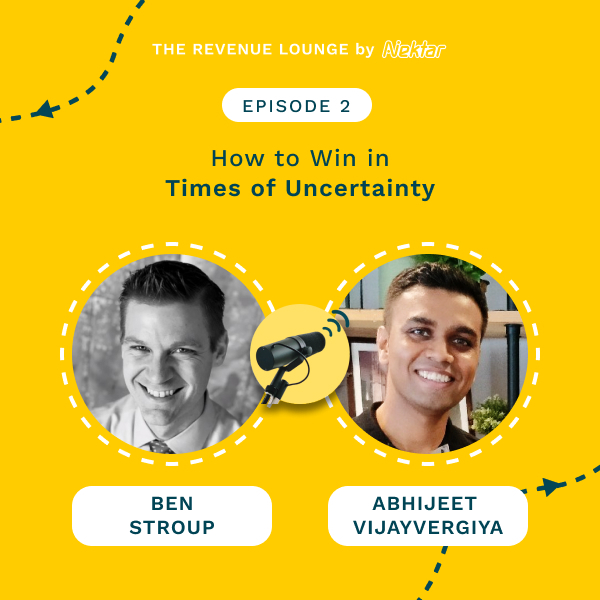
Ep #2: How to Win in Times of Uncertainty
Listen Now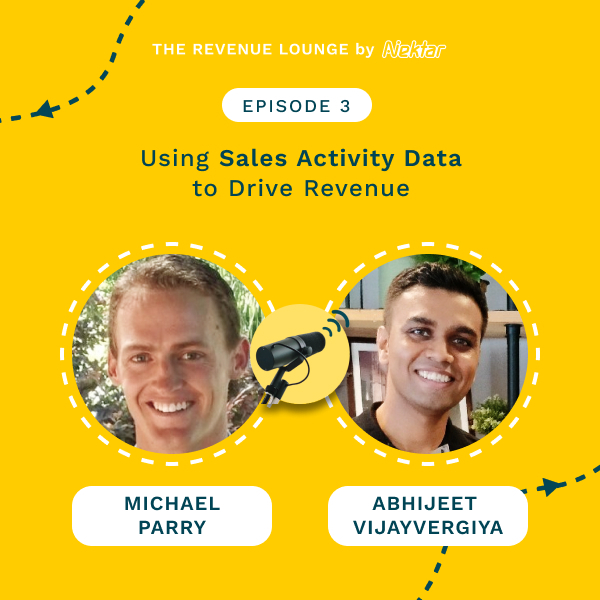
Ep #3: Using Activity Data to Drive Sales Productivity
Listen Now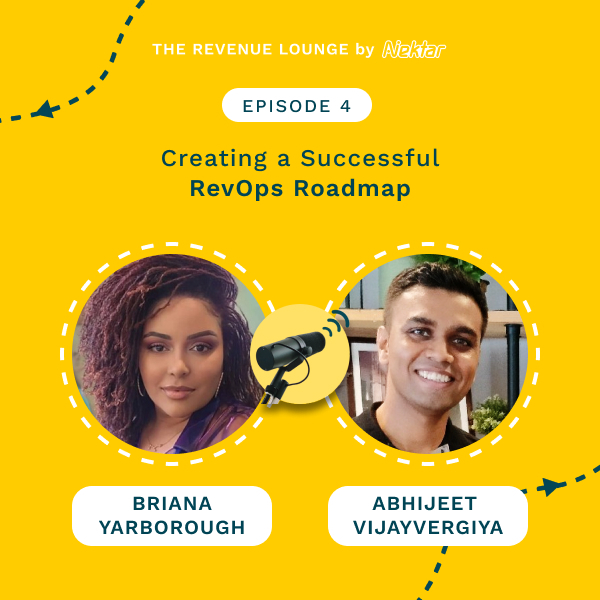
Ep #4: Creating a Successful RevOps Roadmap
Listen Now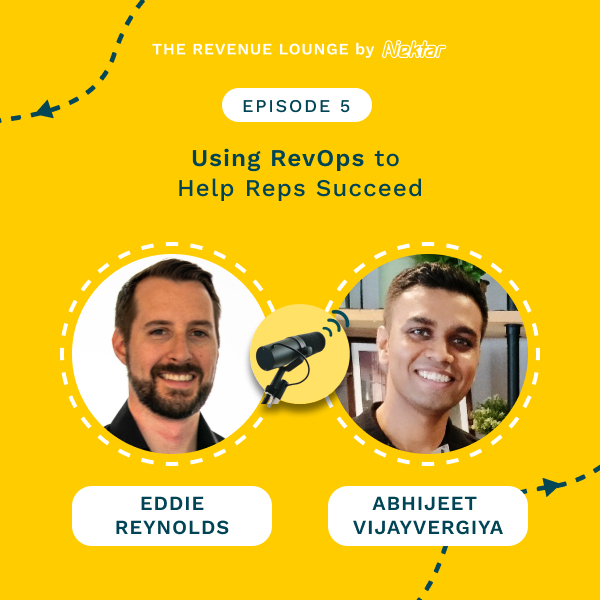
Ep #5: Using RevOps to Help Reps Succeed
Listen Now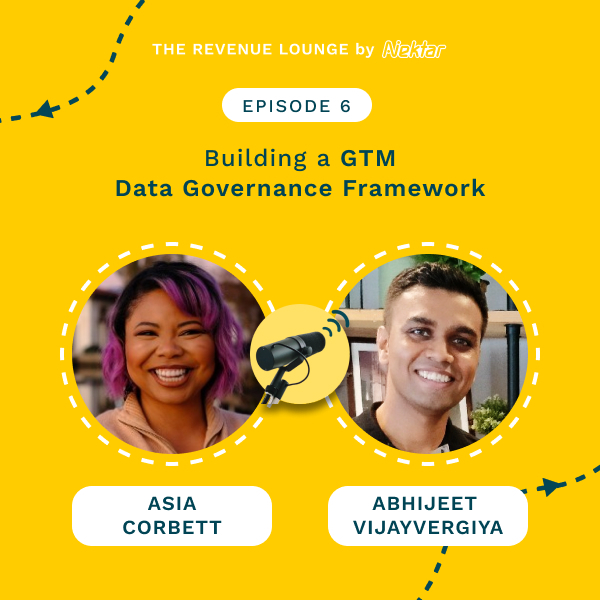
Ep #6: Building a GTM Data Governance Framework
Listen Now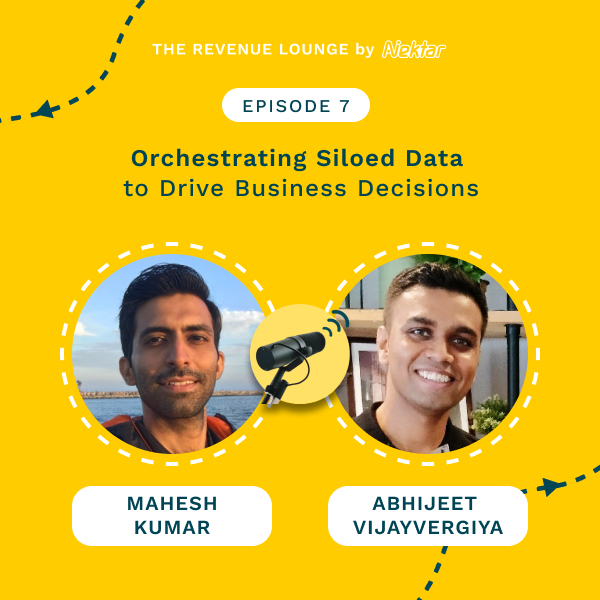
Ep #7: Orchestrating Siloed Data to Drive Business Decisions
Listen Now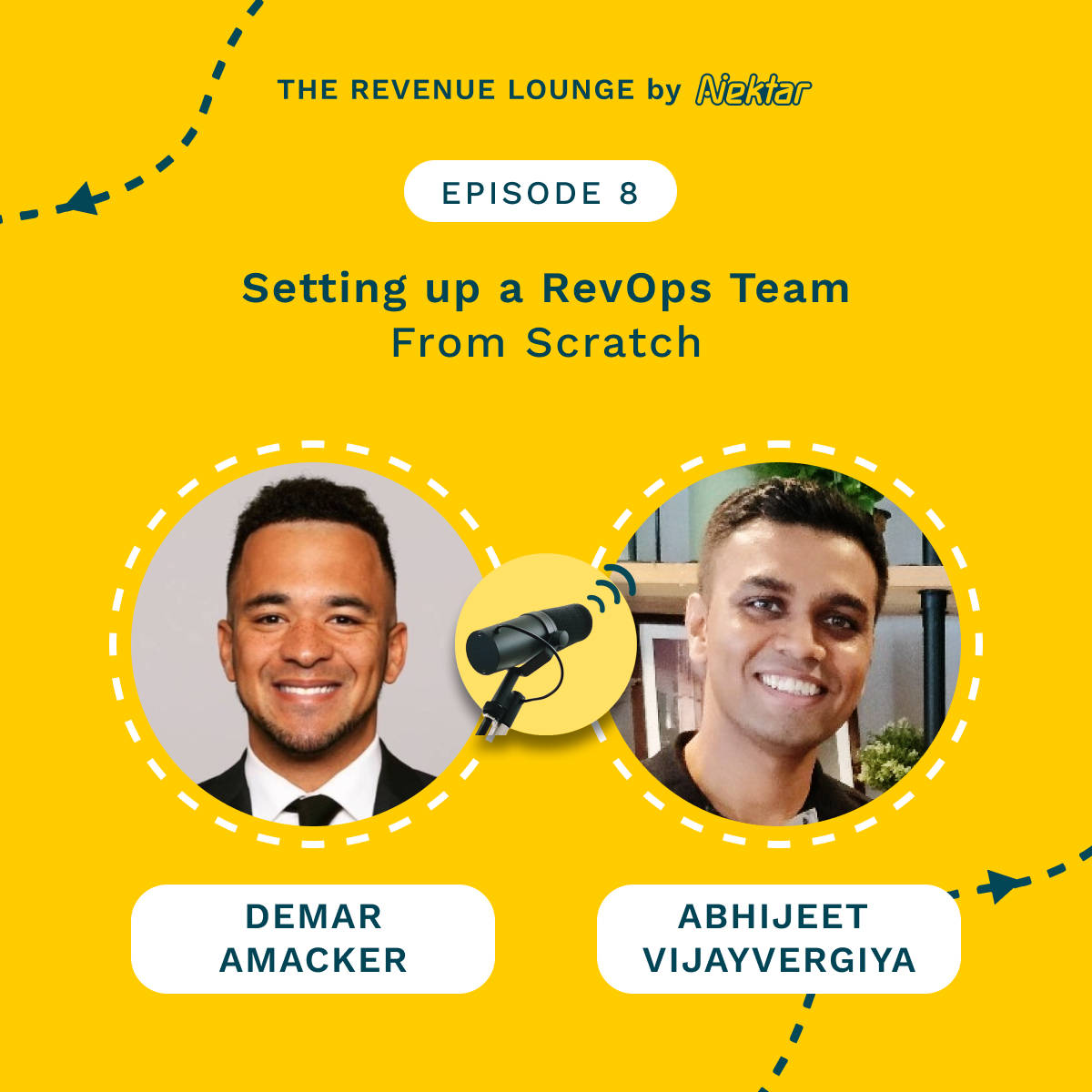
Ep #8: Setting Up a RevOps Team From Scratch
Listen Now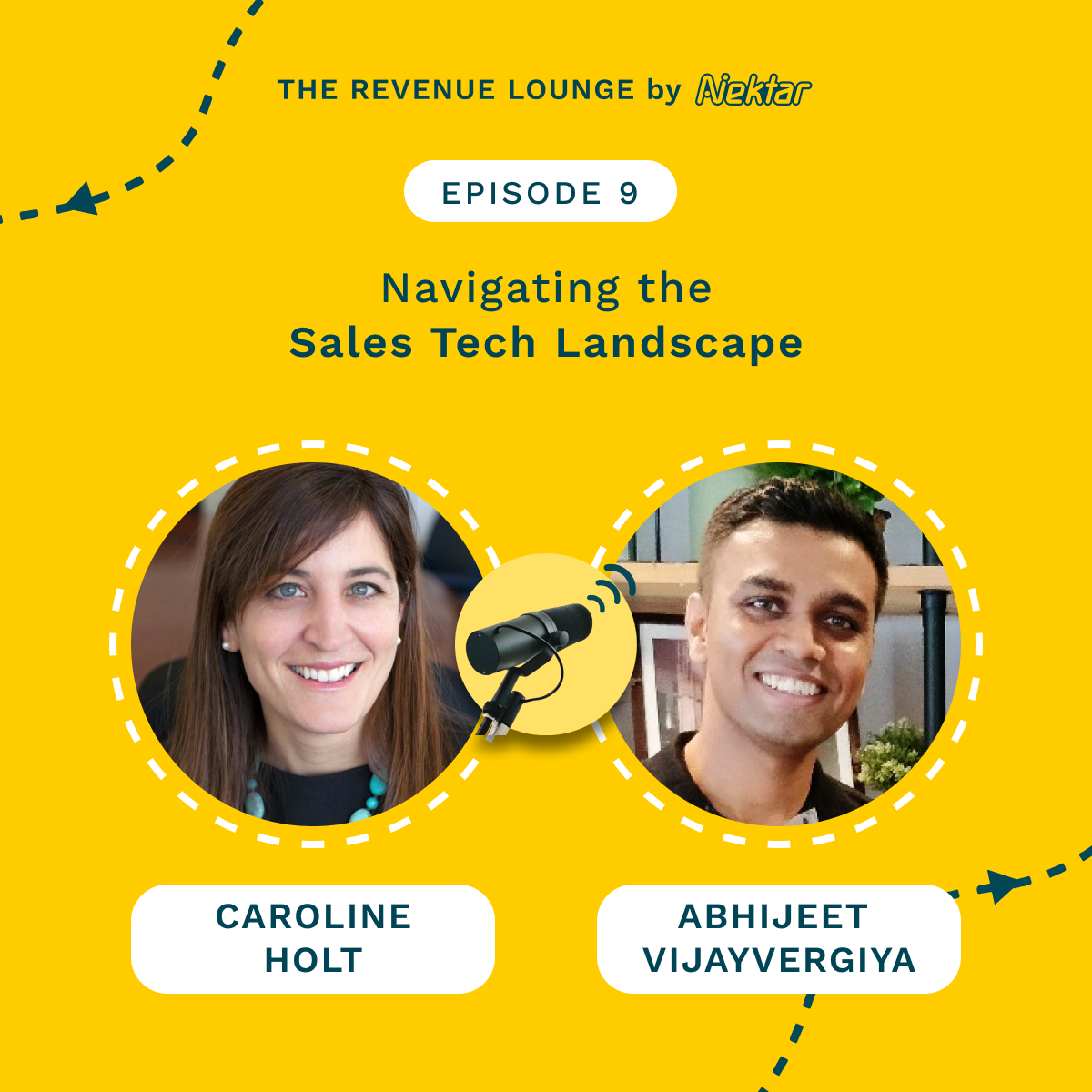
Ep #9: Navigating the Sales Tech Landscape
Listen Now